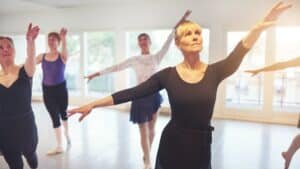
“As soon as I held my paintbrush and stared into the crisp canvas, I couldn’t help but feel like a main character of my movie,” said an empty-nester friend who had been feeling the blues for quite some time. The metaphor was intriguing to me because, in reality, you really are the main character of your life.
Staying exclusively in your comfort zone, however, especially as a senior adult, can make that feeling fade away. Age has a universally negative connotation, and there is no known way to stop it. But we can be alive as we live it! One way to embrace our vitality is to consider a different narrative approach to the subject of risk.
The first step toward fully experiencing life is to move outside of your comfort zone and to think more positively about risk. Just like aging, risk has a negative overlay. Be careful not to fall. Don’t talk on your phone while driving. Don’t be fooled by scams. Of course, all this advice is good. But avoiding all risks is not.
Surely, I won’t be the first person to break the news that taking risks helps achieve greater things, but in this article, I want to be the first person to guide YOU in taking YOUR first creative leap in a long time.
Taking a Step Towards the First Act
Art is the first step of graceful aging for anyone who has entered their third act of life, from retirees experiencing social isolation to empty nesters feeling lonely and alone. Participating in artistic or otherwise creative activities is the only way to be heard above the din of everyday life.
I know firsthand how intimidating it can be to dive headfirst into a new group or endeavor, especially if the atmosphere is cold and uninviting. Many organizations and institutions dedicated to the arts and culture, however, are making efforts to alter this.
Canada’s National Ballet School (NBS) is one such institute that I heartily endorse because of its commitment to diversity and inclusion. Their honest inclusionary efforts have ignited hope in senior adults who intend to explore their artistic abilities.
When I had the fantastic opportunity to interview the NBS game-changers about diversity and inclusion in the arts, I asked their Executive Director, John Dalrymple, for his thoughts on the subject, and his response helped me see the bigger picture.
Inquiringly, “What happens when people walk into our building?” he posed the question. “Do they feel a sense of belonging? Do they see themselves reflected in what we do? And that’s where we had to get more serious about addressing issues with ballet in terms of a lack of inclusion, a lack of diversity, and really, a lack of equity-informed practice within the ballet training world.”
With an outlook of “If we don’t do it, who will?” they took matters into their own hands.
As a result of their tireless efforts, in-house programs like ‘Dance for Life’ now offer senior citizens, people with Parkinson’s, and others in the community access to dance classes and other enriching community activities.
Senior citizens have been dependable bodies as cultural keepers with exceptional social creativity throughout human history. To me, it seems obvious that the more experienced we are, the better off we will be. These individuals have a wealth of experience and emotional depth that they can easily channel anywhere. So what is stopping them today? Maybe their own thinking patterns.
Creative Aging as a Mantra and Addressing Risks, Head On
Despite the positive outlook and aging-related campaigns, the legacy of aging stereotypes seldom fades away. The most apparent ones are the exhaustion of creative vision and a lack of risk-taking enthusiasm. Society believes that as people age, their behavior grows more restrictive and cautious.
I always encourage individuals to take risks in order to amass a wealth of life experiences, particularly in the artistic and cultural realms. Rob Binet, a highly skilled choreographer at the NBS, articulated his ideas in a compelling manner, stating, “Everything that we depend on now as a totally bankable, safe idea was absolutely radical at one point. Swan Lake wasn’t a safe bet when it first went. It was crazy, and it failed, and it took about 10 years before it gained any traction, and now it’s our absolute safest bet.”
In the same way you miss out on so many things when you don’t take risks. Before, people’s options for engaging in creative pursuits were limited. Now, however, the possibilities are practically limitless. The fields of literature, theater, dance, music, crafts, and history awaits our interest.
From joining a book club to taking filmmaking or photography lessons, playing a musical instrument, singing, learning about your city’s history, taking ballet lessons, enrolling in a painting class, or participating in niche interests like foraging or tatting, your options are abundant.
However, the selection from these artistic pursuits is equally important based on health and physical needs. With the help of art in your life, your mind can feel more energized, and your body will thank you every day.
The Positives of Taking Artistic Steps
There is a direct correlation between engaging in cultural pursuits and improved mental health, quality of life, and happiness. Despite the significance of these developments, nothing beats the newly discovered sense of accomplishment.
Achieving something gives you a healthy boost of endorphins, making you feel mentally good. The new addition to your daily routine will brighten your life by ushering in a newer and fresher phase.
Starting with a relaxing pottery class can be an excellent way to boost serotonin levels. When you push yourself to try something new, something you’ve never done before, your confidence and self-esteem skyrocket. We all deserve to feel good about ourselves, so why not treat yourself to a new hobby every now and then?
Engaging in these activities, no matter how large or small, puts your brain under a bit of stress, which is both fun and healthy for your brain. The arts are excellent activities for communication – sometimes even transcending language barriers. Emotional bonds are formed, problems are humanized, and the core of the group is strengthened, which in turn further reinforces the community.
The most compelling argument for starting any artistic journey is its health benefits. Many friends and family members have confided in me about their improved balance and posture. It’s no secret that your body stiffens as you age, and your muscles become rigid. Studies and articles suggest that the cognitive benefits of ballet may extend to seniors and the prevention of dementia.
Much of this is because one must concentrate and memorize numerous combinations in order to complete an action. It is an effective physical therapy exercise for people with osteoporosis and arthritis.
These pursuits also make for a smoother retirement. The prospect of retiring after years of maintaining a professional persona can be daunting. Having hobbies can help you channel your energy into something constructive and give you a sense of direction in your life.
One last fascinating advantage of starting such activities in your senior years is the sheer amount of healthy social interaction throughout the day. Recreational art programs will help you make new friends and will make you more sociable. These art forms help one be in touch with their creative side and shape self-expression.
You are less likely to feel lonely, and sometimes it also gives rise to intergenerational social relationships. A nice cup of coffee with your new friends after a class sounds like a win-win! This trifecta of mental, physical, and social benefits is all you need for a thriving life.
Start Slow to Get the Ball Rolling
Fear of not fitting in can be a valid reason for people not trying in the first place. However, these mental roadblocks are simply mental ifs and buts. At whatever age you are, you must try to challenge yourself. Starting ballet or any other art form requiring physical endurance at a later age isn’t the easiest transition that you can achieve.
You need to take your physical limitations into account in addition to your stamina. As I always say, having a strong determination is essential before venturing out, but it is also critical to recognize and address any shortcomings or challenges along the way.
It’s true that tailoring an experience to fit your unique needs and preferences increases its comfort and enjoyment factor. Similarly, your creative pursuits shouldn’t be confined to cookie-cutter lessons. If the traditional forms are currently inaccessible, consider opting for a different and personalized way to start your journey.
For instance, most written choreography is appropriate for relatively young dancers. In that case, I recommend beginning with a seated ballet barre. This low-impact exercise is ideal for beginners and helps improve balance and coordination.
You may not have the time to do something right now, or you don’t live in a place where it’s possible to do it. Your saving grace may be the availability of relevant online courses.
Contacting a senior center in your area is another great option for narrowing down a list of potential beginnings. Remember that the thresholds at which different people can participate in any given social or artistic activity vary greatly along physical, mental, and temporal dimensions. That friend of yours might be having a great time with an activity but if it isn’t your cup of tea you need to seek a different passion.
Redefine Age to Manifest Happiness
As a child, I was always captivated by professionals who effortlessly displayed their picture-perfect performance art, a pristine glow and halo of enchantment surrounding them. Today, however, I am more captivated by someone’s first attempts and their less-than-perfect first steps.
To help new artistic attempts, small amounts of encouragement can go a long way, so if your partner aspires to try something new, encourage them. If you’re nervous about joining a community, find someone who shares your interests and do activities with them. Sometimes the comfort of company does more than one can imagine. And make a habit of taking risks – one day at a time.
As I close this piece, I can’t help but think of Rob Binet’s inspiring words: “I feel like every time I take a risk, and things aren’t totally destabilized, it creates opportunities for others to take risks, and it lets me take a bigger risk.”
Let’s Have a Conversation:
What artistic risks have you taken recently? How have you benefited from taking those risks? Were you afraid to step forth? How did you conquer your fear of risk?





